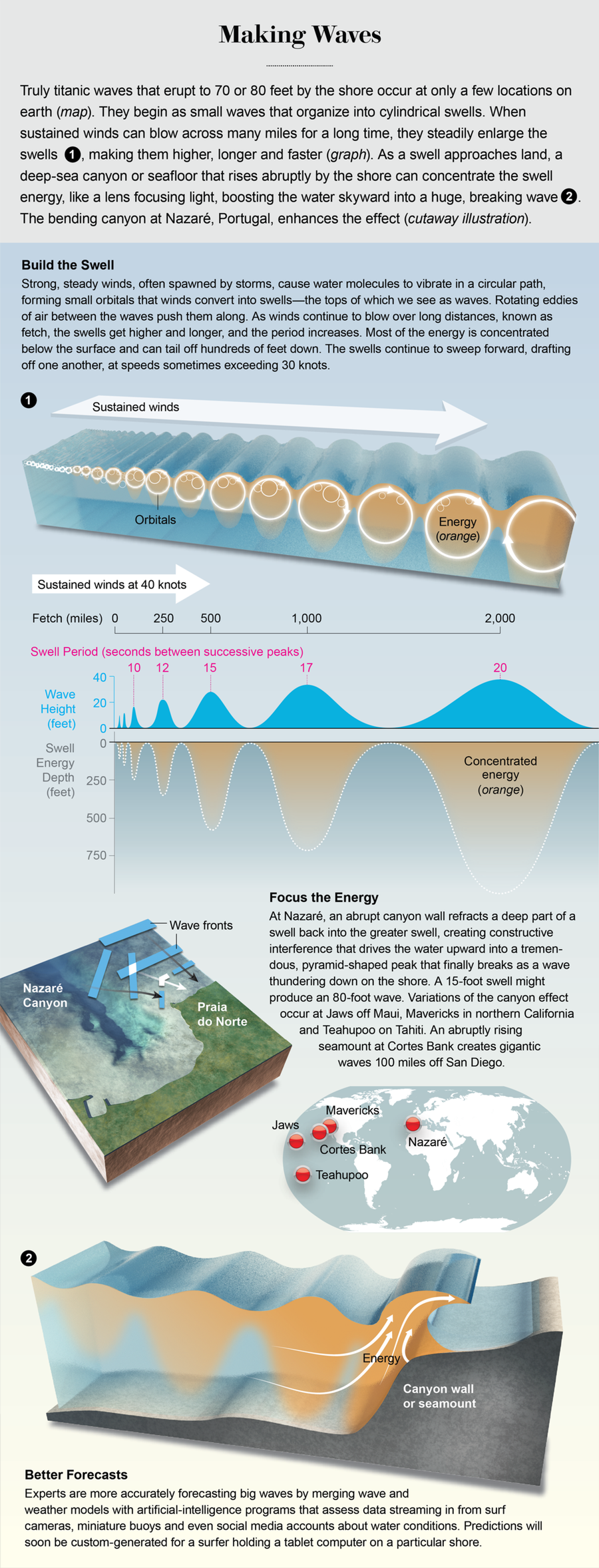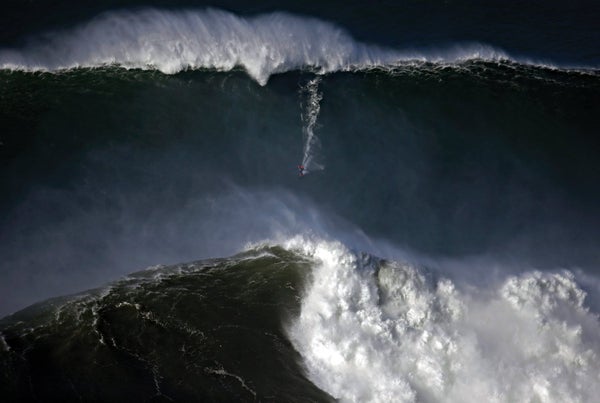Editor’s Note (10/4/18): Brazilian surfer Maya Gabeira has set the world record for the biggest wave ever ridden by a woman—a 68-foot giant along the coast of Portugal—confirmed by Guinness World Records. In August we published the article below, explaining how these monster waves form, and how champion surfers like Gabeira and the male record holder, Rodrigo Koxa, figure out how to ride (and survive) them.
Sleep came fitfully to Rodrigo Koxa during the night of November 7, 2017. The seasoned, 38-year-old big-wave surfer from a tiny island near São Paulo, Brazil, was in the bungalow he had rented for the fall and winter at Nazaré, a fishing village on the central Portuguese coast. In the dark outside, titanic waves were crashing onshore, shaking the ground. “I was telling myself, ‘You gotta go straight down on your wave,’” he recalls, haunted by a bad memory.
October through March is when the huge breakers come to Nazaré. Koxa fixated on his laptop computer, watching animated blobs of yellow, blue and deep purple in the wave forecasts produced by the European weather services, the National Oceanic and Atmospheric Administration and Surfline, a preeminent surf portal. It was evident that the next morning would be go time.
On supporting science journalism
If you're enjoying this article, consider supporting our award-winning journalism by subscribing. By purchasing a subscription you are helping to ensure the future of impactful stories about the discoveries and ideas shaping our world today.
Some of the largest waves on earth had thundered down in plain sight of the village’s residents for 1,000 years, yet they had escaped the surfing world’s attention until November 1, 2011. That was when a Yamaha WaveRunner pilot towed champion surfer Garrett McNamara and his surfboard onto an avalanching wave that Guinness World Records judges declared to be a record 78 feet tall.
Koxa’s first Nazaré attempt came in 2014, and it almost killed him. Immediately after starting a run down a mountain of water, he was nearly crushed against Nazaré’s cliffs. Staring at the forecast in 2017, he knew he would face another giant the next day.
Deep Data
Waves that break at any seashore have a similar genesis. A breeze over the ocean builds small ripples into waves. If strong winds can blow for many miles, the waves become swells that grow and morph into horizontal water columns. Imagine a series of mostly submerged logs in the water rolling toward a coast. If the wave above the sea surface is 10 feet high, the rest of the log might reach hundreds of feet down.
Giant swells are spawned by powerful winds from big storms. The swells barreling toward Nazaré at 35 knots had roared to life during a gale that started four days earlier and 3,000 miles away, between Newfoundland and Greenland. Koxa was able to prepare for them because surf forecasting had advanced tremendously in just the past decade. Early generations of wave models had crunched vast amounts of real-time and recent data from satellite, ship and buoy-borne observations of winds and swells. Predictions about whether big waves would rise near shore came from modeling the interaction of all the data with maps of the seafloor.
In the past few years global wind and wave models have become increasingly precise, as ever more powerful supercomputers assimilate all manner of input data: anything from inch-high capillary waves measured by satellites to tidal currents and the drag that winds encounter over sea ice versus water.

Credit: Don Foley; Source: Sean Collins Surfline (fetch diagram)
Understanding how the seafloor near the shore influences breaking waves has also improved. At Nazaré, one of the world’s most pronounced submarine canyons rises from 16,000 feet of water and more than 125 miles of continental shelf, then funnels right up to the headland onshore. The canyon focuses a wave like light through a lens. It compresses wave energy while the seafloor forces it upward, and the water’s forward momentum creates a towering breaker. “You can have 15 feet of swell in deep water creating a breaking wave up to 80 feet,” says Mark Willis, head of forecasting at Surfline. “The reason is the incredible, exaggerated canyon.”
Despite improvements, the models still struggle with small geographical areas such as Nazaré, says Hendrik Tolman, former director of the Environmental Modeling Center at NOAA. Subtle differences in swell direction or even tidal phase can dramatically reduce or amplify wave heights. Enter machine learning. At its essence, machine learning weaves large quantities of past data with current observations to infer future waves. In a study of California’s Monterey Bay last year, researchers at IBM compiled hourly NOAA weather and wave data from 2013 to 2017 into an enormous spreadsheet 11,078 rows deep and 741 columns wide. When combined with current observations, the artificial-intelligence system led to a 12,000 percent improvement in computational efficiency over models that rely solely on physics of wave and weather dynamics. Surfers, ship captains, wave-energy harvesters and fish farmers will soon be modeling waves at their exact locations—on their iPads.
To further enhance forecasts for specific spots, Willis and Ben Freeston, founder of the Magicseaweed surf portal and Surfline’s director of data science, are using machine learning to essentially create a neural network of added observations from surf cameras and Surfline’s paid reporters; it even includes updates from surfers on social media. Soon, Freeston says, surfers at Nazaré and other big-wave locations—such as Jaws off Maui and Cortes Bank off San Diego [see graphic above]—will be feeding data into AI programs. Tiny data buoys will be deployed outside of the wave zone, transmitting swell data to smartphones being scrutinized by surfers onshore. “Rather than $50,000 or $60,000 NOAA buoys, these can be deployed for 99 bucks,” Freeston says. “Data will rise exponentially.”
Surfing the Dream
Technology does not help a surfer once the person is out in the water, though. Experience is crucial for catching the world’s biggest waves. On the morning after Koxa’s restless night, the swells were approaching the Nazaré shore from the northwest, an ideal angle for the canyon to work its magic. Koxa and a crew of friends marveled as the canyon redirected swells into one another, forming massive, triangular peaks that erupted in front of the headland.
Koxa and his Sea-Doo pilot, Sergio Cosme, circled outside the waves for an hour and a half, but Koxa had yet to catch one. Finally, Cosme hollered, “Big set coming!” Koxa knew that the stiff offshore breeze would make the first wave extremely bumpy, so he held back. The surface of the second wave was cleaner. Then came the third wave. “It was smooth, glassy and beautiful,” Koxa says. “It was so huge. I took one look, but I don’t want to look again. Because if I do, maybe I don’t want to go.”
Cosme towed Koxa to the apex of a wave carrying perhaps a billion watts of power. When Koxa let go of the towrope, seven stories up, he reminded himself of his mantra: “You gotta go straight down.” At that point, he says, “I’m just running for my life. So much energy. I’ve never gone so fast on a surfboard. Then suddenly, I’m in the shadow of the wave. I felt the blackness behind me. But I have enough speed, I think I’m gonna outrun it. And I do. Oh, my God, I just got the wave of my life.”
That ride turned out to be a new world record—the wave was 80 feet from trough to crest, as determined by judges on-site using photographic analysis. At an awards ceremony several months later, Koxa said that the combination of forecasting technology, surfer experience and guts all came together: “It was a dream come true.”

